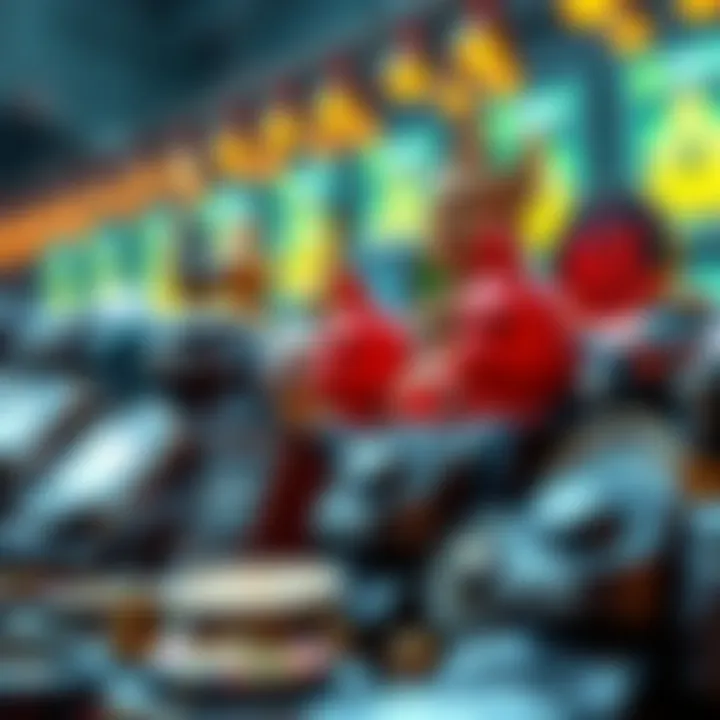Exploring the Purpose and Implications of NFTs


Intro
In recent years, non-fungible tokens (NFTs) have emerged as a significant player in the digital fog of crypto. This article takes a stroll through the tangled woods of NFTs, unpacking their multifaceted roles in various sectors. From the world of art and music to gaming and digital collectibles, it's evident that NFTs are more than just a passing fad. They represent a shift in how we perceive ownership and value in the digital age.
Understanding these tokens requires more than just a passing glance. It's vital for investors, tech enthusiasts, and academics to grasp the nuances surrounding NFTs. Whether you're an artist looking to enter this space or an investor scouting fresh opportunities, this exploration aims to illuminate the path ahead. Through an examination of current market insights, blockchain innovations, and future implications, we will build a comprehensive overview of NFTs.
The essence of NFTs lies in their uniqueness. Unlike cryptocurrencies that can be exchanged for one another, NFTs offer a distinct piece of ownership tied to a digital item. This property of non-fungibility opens up a treasure trove of opportunities, but also brings forth challenges that cannot be ignored. As we embark on this journey, we will delve into the significance of NFTs in asset ownership and the creator economy, as well as their potential to upend traditional industries. We will also wade into the risks and hurdles this technology faces, ensuring a balanced view of its potential.
The aim here is not just to inform, but to spark thought. Why do NFTs matter? What goes into their valuation? And what implications do they hold for the future of digital ownership? Let's begin to peel back the layers.
Understanding Non-Fungible Tokens
In an age where the digital landscape is evolving at a breakneck pace, understanding non-fungible tokens (NFTs) is more than just a trend; it's a necessity for anyone invested in the future of digital assets. The importance of NFTs cannot be overstated, as they represent a significant shift in how we perceive ownership and value in a digital world. These tokens are unique, unlike conventional cryptocurrencies such as Bitcoin or Ethereum, which are interchangeable. NFTs are paving the way for new forms of commerce and creativity, compelling us to confront questions about value, authenticity, and intellectual property in ways we never have before.
A key point to consider is that NFTs allow creators – from artists to musicians to game developers – to monetize their work in unprecedented ways. Rather than relying on intermediaries, these tokens empower creators to have direct access to their audiences. This shift has implications not only for individual artists but also for industries as a whole. Moreover, NFTs introduce a new layer of scarcity in the digital realm, echoing the principles we've traditionally associated with physical art and collectibles.*
Furthermore, as we journey through this article, we will explore the diverse applications of NFTs that extend beyond art and music. This understanding will equip you with insights necessary for navigating a rapidly changing technological environment. Whether you are an investor hoping to capitalize on trends, a tech enthusiast eager to understand the mechanics, or an academic interested in future implications, grasping the foundational aspects of NFTs is critical in making informed decisions.
Definition of NFTs
Non-fungible tokens, or NFTs, are distinct digital assets verified using blockchain technology. Each NFT holds unique information that distinguishes it from every other token—much like a fingerprint or a snowflake. Essentially, NFTs serve as certificates of ownership for digital goods. This could range from images, videos, music files to tweets and even virtual real estate. To say it simply, ownership of an NFT translates to owning something that cannot be duplicated, which is a crucial feature in a world flooded with copies and replicas.
Key characteristics of NFTs include:
- Uniqueness: Each token has unique metadata, ensuring its one-of-a-kind status.
- Indivisibility: Unlike cryptocurrencies that can be divided into smaller units, NFTs exist as whole assets.
- Interoperability: Built on standard protocols, NFTs can exist across various platforms and marketplaces, increasing their usability.
Despite the buzz surrounding them, it's worth noting that the ownership of an NFT does not equate to copyright ownership unless specified. Hence, understanding the legal implications is vital as we delve deeper into this innovative realm.
Distinction Between Fungible and Non-Fungible Tokens
To grasp the concept of NFTs fully, it's essential to differentiate them from fungible tokens. Fungible tokens are interchangeable and identical assets, which means one unit is essentially equal to another. Take, for instance, a dollar bill; it doesn't matter if you have one dollar bill in your wallet or another; their value holds the same. This concept applies to cryptocurrencies as well: one Bitcoin equals another Bitcoin.
However, non-fungible tokens twist this notion on its head. Each NFT is uniquely identifiable and cannot simply be exchanged on a one-to-one basis. Consider a MoMA painting; even if copies exist, the original holds unmatched value and authenticity. This divergence has immense implications for collectors, investors, and creators alike.
In business-oriented terms, the distinctions can be summarized as:
- Fungible Tokens: Uniform, interchangeable, divisible (e.g., cryptocurrencies).
- Non-Fungible Tokens: Unique, non-interchangeable, indivisible (e.g., digital art, collectibles).
Recognizing these differences lays the groundwork for understanding the heightened value placed on unique digital assets and invites us to explore their various implications in the economy and cultural landscape.
The Technical Framework of NFTs
Understanding the technical underpinnings of non-fungible tokens (NFTs) is crucial for anyone looking to grasp their impact and potential. This framework offers the backbone that allows NFTs to function as unique digital assets. With a growing interest in the digital economy, it becomes essential to analyze how NFTs utilize blockchain technology and smart contracts. These elements not only facilitate the creation and transfer of NFTs but also ensure their security and authenticity.
Blockchain Technology Underpinning NFTs
Blockchain technology serves as the bedrock for NFTs, providing a tamper-proof and transparent ledger for recording transactions. In simple terms, a blockchain is like a digital notebook that everyone can see but no one can erase once something is written down.
Imagine a community ledger where each entry is public and permanent. This is vital for NFTs because it assures buyers of ownership and helps secure the value of these assets. NFTs are minted on various blockchain platforms, each with their own strengths. Ethereum, for example, is the most widely adopted blockchain for NFTs, thanks to its robust infrastructure and large community.
The main benefits of blockchain for NFTs include:
- Decentralization: No single entity controls the data, reducing the risk of censorship.
- Security: Data is encrypted and replicated across all nodes, making it nearly impossible to alter transaction records.
- Transparency: All transactions are publicly visible, fostering trust among users.
However, there are also considerations related to blockchain technology. For instance, the energy consumption associated with certain blockchains has raised concerns about their environmental impact. Moreover, since transactions can sometimes take time to process, the immediate liquidity of NFTs can be affected.


Smart Contracts and Their Role in NFTs
Smart contracts are another pivotal element in the NFT ecosystem. Simply put, a smart contract is a self-executing contract with the agreement directly written into code. Think of it like a vending machine: you put in money, and the machine automatically delivers the product without the need for any intermediary.
In the context of NFTs, smart contracts automate various aspects of the transaction process, which offers several advantages:
- Automated Transactions: Once conditions are met, the contract executes automatically, thereby reducing the need for manual intervention.
- Royalty Payments: Artists can program smart contracts to automatically distribute royalties every time their NFT is sold in secondary markets, ensuring continuous revenue.
- Ownership Verification: Smart contracts verify ownership and authenticity of the NFT, providing peace of mind to buyers regarding their investment.
Nevertheless, smart contracts are not foolproof. A poorly coded contract can lead to vulnerabilities, leaving assets open to exploitation. Additionally, because they operate on predetermined codes, any errors can be challenging to rectify, as they often require the involvement of developers for fixes.
"A well-designed smart contract can be the difference between success and failure in the NFT landscape."
In summary, the technical framework of NFTs, including blockchain technology and smart contracts, underpins their functioning and integrity. This foundation is essential for investors, tech enthusiasts, and academics alike, as it demystifies the mechanics that allow these digital assets to thrive in an ever-evolving digital landscape.
For more information about blockchain technology, you can visit Wikipedia. To dive deeper into smart contracts, you may check resources like Britannica or forums such as Reddit.
Applications of NFTs
The prominence of non-fungible tokens (NFTs) in the digital arena has dramatically altered various sectors, signaling a shift in how assets are perceived, traded, and owned. As consumers and creators alike navigate this burgeoning landscape, it becomes increasingly essential to delve into the multifaceted applications of NFTs. From art to virtual gaming realms, these tokens serve not only as collectibles but also as a conduit for innovation.
NFTs furnish various sectors with benefits that transcend traditional paradigms. They enable a mechanism for verified ownership that transcends geographical limitations. This is crucial in industries where authenticity and provenance can significantly impact financial value.
Art and Digital Collectibles
In the art world, NFTs have stirred quite the excitement. Imagine an artist breathing life into a canvas and then minting that artwork as an NFT. Collectors can purchase original pieces with the assurance of rarity and ownership recorded securely on the blockchain. Artists such as Beeple have made headlines, selling digital works for millions. This not only challenges conventional art markets but encourages a new generation of artists to explore digital mediums.
These digital collectibles, however, come with their own set of considerations. There’s an ongoing debate about the longevity and sustainability of digital art as a market. Some critics argue that the hype will inevitably fizzle out. Yet, many artists view NFTs as a breakthrough opportunity to interact directly with their audience, eliminating middlemen. Buyers gain exclusive ownership rights, often bundled with additional perks like limited edition prints or behind-the-scenes access.
Gaming and Virtual Real Estate
NFTs have found fertile ground within the gaming sector. Game developers are harnessing this technology to create unique in-game items, ranging from skins to digital land. For instance, a rarity-enhanced sword in a game like Axie Infinity can command a hefty sum on secondary markets. This transforms the player’s experience into a tangible investment opportunity, redefining how players view their time and money spent in virtual realms.
Virtual real estate operates on similar principles. Platforms like Decentraland enable users to buy, sell, and barter plots of virtual land. These parcels, authenticated through NFTs, can be developed into anything from virtual marketplaces to concert venues. Users step into a digital ecosystem with actual economic implications, as engagement can translate into real-world profits. The compensatory structure encourages creativity and investment from users, blurring the lines between gaming and commerce.
Music and Entertainment Industry
NFTs are revolutionizing the music and entertainment fields as well. Artists can release albums or singles as NFTs, providing fans with exclusive access to tracks, music videos, or personal interactions through virtual meet-and-greets. Kings of Leon, for instance, pioneered the move by offering an album release as an NFT, complete with perks like front-row concert tickets. This model allows musicians to carve out new revenue streams, reducing dependence on traditional label contracts and empowering them to maintain ownership of their work.
However, as with any emerging tech, there are pitfalls. The transition to NFTs raises questions about copyright laws and the rightful ownership of digital rights. Additionally, the environmental concerns associated with minting NFTs pose ethical dilemmas for the industry as a whole, given the energy-intensive processes in mining cryptocurrencies.
"NFTs offer a revolutionary approach, yet with great power comes great responsibility. Balancing innovation with ethical considerations will dictate the future of digital ownership."
As industries continue to adopt NFTs, the key lies in understanding both the advantages and challenges presented. The applications of NFTs are diverse and evolving, serving as a testament to how technology reshapes our perceptions of ownership, creativity, and commerce.
NFTs in the Creator Economy
As we delve into the creator economy, one cannot overlook the seismic shift brought about by non-fungible tokens, or NFTs. These digital assets are not just a mere fad; they serve as a powerful tool for artists, musicians, and content creators to gain control over their work and directly engage with their audience. In a world rife with piracy and content theft, NFTs have emerged as a beacon of hope, offering a structured way for creators to protect their intellectual property while reaping the rewards of their labor.
Empowering Artists and Creators
The advent of NFTs has empowered artists in ways that few other innovations have. Traditional pathways to success in art often involve galleries, agents, and middlemen who take substantial cuts from sales. This means artists rarely see the full financial fruits of their creation. Now, with platforms like OpenSea and Rarible, artists can sell their work directly to collectors, cutting out those intermediaries entirely.
- Direct Sales: Artists can set their own prices and sell directly on marketplaces. This not only ensures better profit margins but also fosters a more authentic connection with buyers.
- Global Reach: Using blockchain technology, creators can reach a global audience, transforming local talent into worldwide sensations overnight.
- Community Engagement: NFTs allow for the creation of exclusive communities, where fans can interact with artists and fellow enthusiasts. This enhances the relationship between creators and their supporters.
In essence, NFTs enable artists to craft their own narratives. They can produce limited edition pieces, give fans behind-the-scenes access, or even share their creative process through integrated features. This shift reignites the artist's agency, allowing them to wear multiple hats as creator, marketer, and business owner—all in one.
Royalties and Revenue Streams


One of the most significant benefits of NFTs lies in the revenue mechanisms they offer. Unlike traditional art sales where artists earn money only from the first sale, NFTs can include smart contracts that automatically pay creators a percentage each time their digital asset is sold in the future. This has profound implications:
- Ongoing Earnings: Creators can benefit from the appreciation of their work over time. If an artist's work becomes highly sought after, they continue to earn from its resale, ensuring sustainable income.
- Diverse Income Streams: Beyond initial sales, NFTs open doors to alternative monetization avenues such as:
- Membership Tokens: Creators can offer exclusive content or experiences to token holders.
- Collaborations: They can partner with other artists or brands to create unique NFTs that draw in diverse audiences.
- Merchandise: Creators can bundle physical merchandise or services with NFT purchases, enhancing value for fans.
The ability to program these features into NFTs means that creators can build a revenue model that is as dynamic as their work itself.
"NFTs transform the traditional creator economy, aligning the interests of artists and their audiences in new, lucrative ways."
In summary, the emergence of NFTs in the creator economy is more than just a trend; it is a revolution that reshapes how creators engage with their work and their audiences. From empowering artists to innovate in their revenue strategies, the implications are profound. With these tools at their disposal, artists can thrive in a digital world that once seemed hostile to their interests.
NFTs in Business and Commerce
In today’s fast-paced economy, NFTs are carving out a distinct niche in the business and commerce landscape. The potential for these tokens extends far beyond the realms of digital art and collectibles, reaching into sectors such as brand strategy, marketing innovation, and asset management. Businesses are starting to realize that these unique digital tokens can fundamentally shift how value is created, exchanged, and perceived.
One standout benefit of NFTs is their ability to enhance customer engagement through creative branding. By integrating NFTs into their marketing strategies, companies craft experiences that resonate with consumers on a deeper level. For instance, some brands have started releasing limited-edition NFTs that provide ownership of exclusive content, thereby fostering a sense of community among their consumers. This direct connection not only adds a layer of loyalty but also sparks conversations around the brand, effectively leveraging social proof as a marketing tool.
Moreover, NFTs enable decentralized ownership which reshapes traditional business models. Businesses can now tokenize their products and services. This tokenization streamlines transactions as consumers purchase products or services through NFTs, cutting out intermediaries and reducing costs. This is particularly advantageous in sectors where transparency and trust are paramount, as the blockchain records every transaction.
"Tokenization allows for fractional ownership of assets, enabling a wider audience to invest in high-value items they might not otherwise afford."
As organizations endeavor to pivot in response to changing market dynamics, the integration of NFTs can pave the way for innovative revenue streams that were previously unimaginable. Licensing agreements, royalties from digital usage, and collaborations can now be automated through smart contracts linked to NFTs, ensuring creators and brands gain fair compensation efficiently. This represents a significant shift in how businesses can manage their assets and relationships with creators.
Branding and Marketing Innovations
The marriage of branding and NFTs signifies a shift in how companies perceive and engage with their audiences. With an NFT strategy, businesses can create a unique narrative around their brand. This could involve creating collectible tokens related to a brand’s history, special events, or even consumer milestones. Each NFT becomes a storytelling piece, representing not just a product, but an experience.
Additionally, NFTs can transform loyalty programs. Instead of the traditional point systems, companies can issue NFTs that represent rewards, discounts, or exclusive access to events. This unique approach can drive customer retention and encourage brand ambassadorship, as consumers can buy, sell, or trade their rewards in secondary markets. It's an innovative twist that enhances consumer interaction while making the brand more memorable.
Tokenization of Real-world Assets
The tokenization of real-world assets is another compelling avenue for NFTs within business and commerce. This concept allows tangible items—like real estate, luxury goods, and even intellectual property—to be represented as digital tokens on the blockchain. This opens doors to liquidity where traditionally illiquid assets can be broken down into smaller, tradable units.
For instance, let’s consider real estate. By tokenizing a property, multiple investors can own fractions of that asset, allowing for investment diversification and access to the real estate market for those who may have previously found it unattainable. This model can lead to increased capital infusion into projects and broaden investment opportunities for everyday individuals.
Furthermore, the structure of blockchain technology ensures that ownership records are secure, verifiable, and transparent. Transactions become more trustworthy as they’re recorded on an immutable ledger, establishing clear proof of ownership. This can greatly reduce disputes related to ownership and sales, paving the way for smoother transactions in various sectors.
For further exploration on this in-depth subject, the following references can provide more insights: Wikipedia on NFTs, Britannica.
For discussions and updates related to NFTs, interested parties can also visit Reddit’s NFT community.
Legal and Ethical Considerations
The rise of non-fungible tokens (NFTs) has brought to the forefront significant legal and ethical discussions. One of the most pivotal aspects of NFTs lies in how ownership is framed within a digital context. As art, music, and other creative works transition to digital forms, questions about rightful ownership and how intellectual property laws adapt to these changes emerge. Moreover, the implications of NFTs extend to the environmental realm, raising concerns about sustainability as blockchain technology consumes vast amounts of energy. In this section, we’ll take a closer look at the facets of ownership and intellectual property rights alongside the environmental concerns associated with NFTs.
Ownership and Intellectual Property Rights
When it comes to NFTs, understanding ownership is like navigating a maze. Individuals might purchase an NFT and think they own the artwork or music it represents, but the reality is more complicated. The buyer typically acquires a token that proves ownership on the blockchain, but that doesn’t automatically confer copyright or full proprietary rights over the underlying content.
- What Does Ownership Mean?
For instance, if someone buys a digital painting as an NFT, the token represents proof of ownership of that specific instance of the art. However, the artist retains the rights to reproduce the work or create derivative works unless explicitly transferred. This ambiguity can lead to disputes, especially when a collector or investor feels entitled to more than what was originally agreed upon. - Transferability of Rights
To address this, creators can embed legal agreements into the smart contract of the NFT. This could stipulate what rights are being sold along with the NFT. Such efforts aim to protect both the creator’s intellectual rights and the buyer’s understanding of what they’re actually purchasing.
"The ownership debate around NFTs is an evolving dialogue, where creators and buyers alike must navigate complex waters of intellectual property."
Understanding these dynamics is vital for all parties involved. As NFTs continue to proliferate, familiarizing oneself with the legal implications is paramount for investors and creators alike.


Environmental Impact and Sustainability Issues
NFTs have not escaped scrutiny regarding their environmental footprint. The blockchain networks that support many NFTs, particularly those built on Ethereum, face criticism for their significant energy consumption. The proof-of-work mechanism that underpins these blockchains relies on complex computational processes that require vast amounts of energy. This dependency raises questions about sustainability in light of ongoing climate change.
- Energy Consumption Concerns
A transaction involving an NFT can consume as much energy as a typical household uses in a week. Critics argue that if the digital art and collectibles boom continues unchecked, it could exacerbate the already critical climate crisis. - Alternative Solutions
Some platforms are shifting towards more energy-efficient methods, such as proof-of-stake, which does not require the same level of computational power. These alternatives represent a proactive step towards creating a more sustainable NFT ecosystem. For example, platforms like Tezos have been celebrated for their lower carbon footprint, making them attractive options for environmentally conscious creators and buyers. - Impact on Market Trends
Furthermore, as awareness grows, there is a rising demand for transparency in the environmental impacts of NFTs. Investors today are more inclined to support projects that emphasize sustainability, potentially influencing market trends and valuations.
Ensuring a responsible approach to NFTs necessitates a balance between growth and ethical practices. This segment highlights that amid the promise of disruption, scrutiny of legal frameworks and environmental impacts underscores the complexity of integrating NFTs into our lives.
Challenges and Criticisms of NFTs
The topic of challenges and criticisms surrounding NFTs is crucial to understanding their full impact on the digital landscape. While NFT technology offers extraordinary possibilities, it’s not all sunshine and rainbows. The issues at hand expose the darker sides of this seemingly revolutionary technology. Investors, tech enthusiasts, and academics alike should grasp these nuances, as they pave the way for informed discussions about the future of NFTs.
Market Volatility and Speculation
The hype surrounding NFTs has led to significant market volatility. Prices can swing like a pendulum, often influenced more by trends and hype than intrinsic value. This highs-and-lows nature can foster speculation, enticing risk-tolerant investors hoping to cash in on rising values.
- The price of a digital artwork by Beeple sold for $69 million in March 2021 shocked the world; however, many lesser-known NFTs have witnessed rollercoaster price drops soon after their initial boom.
- Investors often find themselves in a frenzy to grab the next trending piece, fueling an environment characterized by speculation.
This volatile nature raises questions about true value. What are these assets worth if their price is not tethered to consistent demand or utility? Market corrections could wipe out speculative wealth, leaving some investors in the lurch. As individuals dive into NFTs, being mindful of the risks is fundamental. In this landscape, profits should never be taken for granted; they are often as fleeting as a mirage.
Scams and Fraud in the NFT Space
The NFT realm is not immune to nefarious activities. With rapid growth attracting a diverse crowd—from seasoned collectors to novices—fraudulent schemes have popped up with alarming frequency.
- Counterfeit NFTs: Unscrupulous individuals create fake listings for artworks, often passing off someone else's work under their own name. This leads to buyers acquiring assets they believe are original when they’re mere copies. This raises significant ethical questions regarding intellectual property.
- Rug Pulls: In some cases, projects surface that promise unique digital assets but lack any foundation. Creators gather funds and disappear, leaving investors high and dry.
"One of the most prominent imperatives in the NFT space is due diligence, as the difference between a legitimate asset and a scam may be a click away."
- Phishing Scams: As with other digital platforms, phishing attempts are a threat. Individuals may receive seemingly legitimate communication requesting their private keys or wallet information, only to find themselves locked out of their accounts after falling into the trap.
In a market where the security of assets is critical, ensuring safety and legitimacy is paramount. Investors are urged to perform due diligence and engage with reputable platforms to navigate these waters responsibly.
While the challenges and criticisms of NFTs may raise eyebrows, it is essential for those interested in this space to maintain a critical lens. Understanding these issues in context can aid in creating a more secure and sustainable future for non-fungible tokens. For further insights into these complexities, resources like Wikipedia and Britannica can provide valuable information.
Future Trends in NFTs
The future of non-fungible tokens (NFTs) is a tantalizing blend of innovation, collaboration, and a few unknowns. As the digital world evolves, so do the capabilities and applications of NFTs. This section will shed light on two particularly exciting trends: the integration of NFTs with augmented and virtual reality, as well as the push towards interoperability between platforms. Understanding these trends is crucial for investors, tech enthusiasts, and academics keen on grasping where the NFT market could be heading.
Integration with Augmented and Virtual Reality
The emergence of augmented and virtual reality (AR and VR) technologies has opened brand new frontiers for NFTs. Imagine stepping into a fully immersive digital gallery, viewing and interacting with 3D representations of artworks, all of which are verified as unique through NFTs. This is not just a flight of fancy; it’s already happening in various forms.
As these technologies become more mainstream, the potential for combining NFTs with AR and VR creates unique opportunities for creators and collectors alike. Artists can now not only sell digital representations of their works but also create environments where potential buyers can experience those artworks in an interactive and engaging manner.
Furthermore, this blend makes it easier for creators to demonstrate their works in contexts that emphasize their value—whether it's a rare sneaker displayed in a virtual showroom or a unique piece of land in a VR game like Decentraland.
"The synergy between VR, AR, and NFTs could redefine how value is perceived in the digital realm."
Yet, this integration comes with its own set of challenges, mainly concerning accessibility and the technological barriers that may alienate some users. The devices needed to enjoy true AR and VR experiences can be costly and not widely adopted, but as these technologies become more affordable, we might see a significant shift in how NFTs are perceived in the broader market.
Interoperability Between Platforms
Interoperability in the NFT space signifies the ability for users to buy, sell, and trade NFTs across different platforms without being tied to a single ecosystem. This shift could revolutionize how NFTs are exchanged, opening doors to a broader market and allowing for a seamless user experience.
Currently, many NFTs exist in silos on specific platforms, creating a fragmented ecosystem. However, as developers work towards creating standardized protocols, the prospect of cross-platform compatibility is becoming more achievable. This means that an NFT purchased on one marketplace may also be displayed or utilized in another, growing its utility and market value immensely.
Benefits of interoperability include:
- Increased liquidity: The ability to trade NFTs across multiple marketplaces increases the number of potential buyers and sellers.
- Enhanced user experiences: Users will have the freedom to interact with their NFTs in various environments.
- Innovative applications: The combined capabilities of different platforms will lead to unique uses of NFTs.
Despite the clear advantages, this innovation does face several hurdles, such as differing standards between platforms and potential security concerns. But the desire for a more interconnected digital landscape is a powerful driving force, suggesting that the NFT ecosystem will likely evolve in this direction over time.
As we venture further into the world of non-fungible tokens, staying informed about these upcoming trends is vital for anyone invested in the digital economy. Understanding how NFTs might intersect with new technologies will not only inform strategic decisions but also showcase where this unique asset class is headed.







